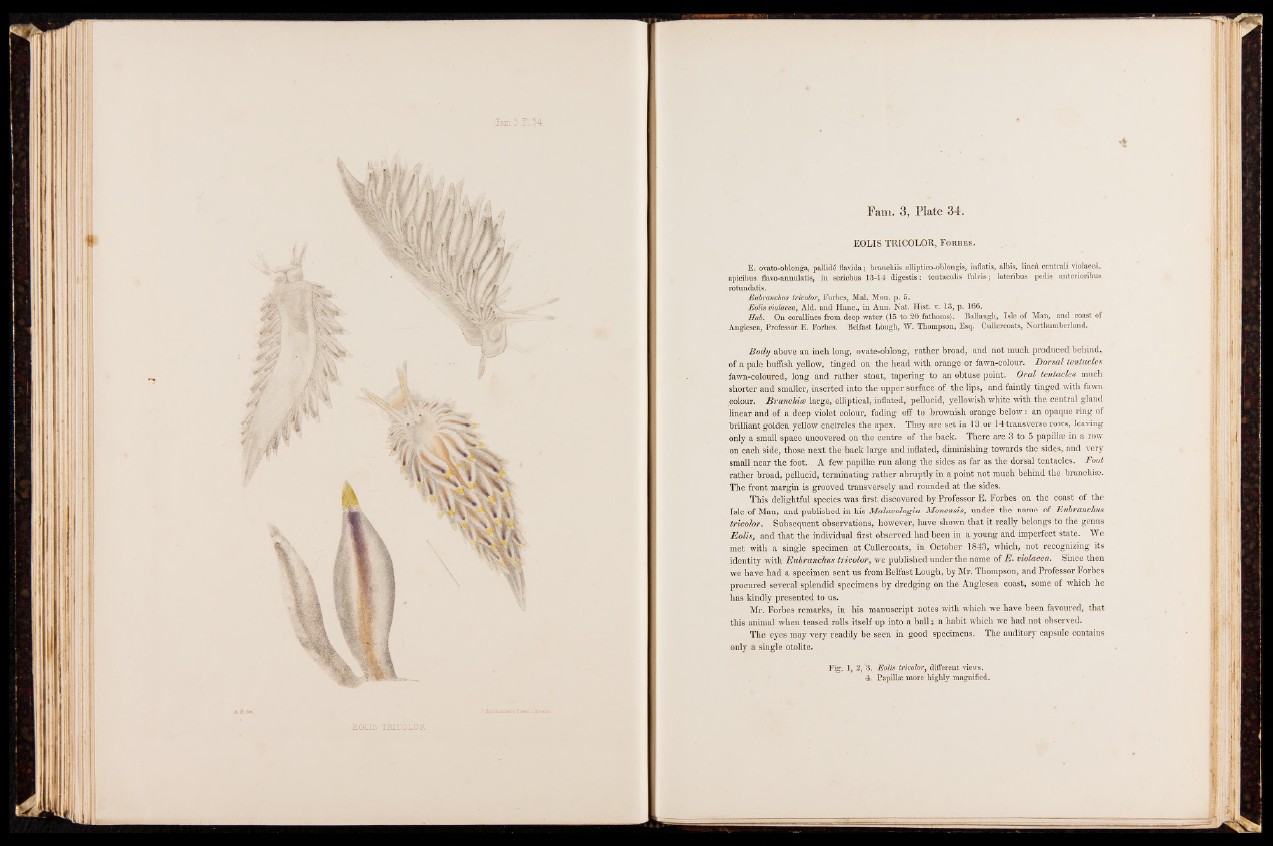
Fam. 3, Plate 34.
EOLIS TRICOLOR, Fokbes.
E. ovato-oblonga, pallide flavida; branchiis elliptico-oblongis, inflatis, albis, linea centrali violacea,
apicibus flavo-annulatis, in seriebus 13-14 digestis: tentaculis fulvis ; lateribus pedis anterioribus
rotundatis.
Eubranchus tricolor, Forbes, Mai. Mon. p. 5.
Eolis violacea, Aid. and Hanc., in Ann. Nat. Hist. v. 13, p. 166.
Hab. On corallines from deep water (15 to 20 fathoms). Ballaugh, Isle of Man, and coast of
Anglesea, Professor E. Forbes.' Belfast Lough, W. Thompson, Esq. Cullercoats, Northumberland.
Body above an inch long, ovate-oblong, ratber broad, and not much produced behind,
of a pale buffish yellow, tinged on the head with orange or fawn-colour. Dorsal tentacles
fawn-coloured, long and rather stout, tapering to an obtuse point. Oral tentacles much
shorter and smaller, inserted into the upper surface of the lips, and faintly tinged with fawn
colour. jBranchice large, elliptical, inflated, pellucid, yellowish white with the central gland
linear and of a deep violet colour, fading off to brownish orange below: an opaque ring of
brilliant golden yellow encircles the apex. They are set in 13 or 14 transverse rows, leaving
only a small space uncovered on the centre of the back. There are 3 to 5 papillae in a row
on each side, those next the back large and inflated, diminishing towards the sides, and very
small near the foot. A few papillae run along the sides as far as the dorsal tentacles. Foot
rather broad, pellucid, terminating rather abruptly in a point not much behind the branchiae.
The front margin is grooved transversely and rounded at the sides.
This delightful species was first discovered by Professor E. Forbes on the coast of the
Isle of Man, and published in his Malacologia Monensis, under) the name of Eubranchus
tricolor. Subsequent observations, however, have shown that it really belongs to the genus
Eolis, and that the individual first observed had been in a young and imperfect state. We
met with a single specimen at Cullercoats, in October 1843, which, not recognizing its
identity with Eubranchus tricolor, we published under the name of E . violacea. Since then
we have had a specimen sent us from Belfast Lough, by Mr. Thompson, and Professor Forbes
procured several splendid specimens by dredging on the Anglesea coast, some of which he
has kindly presented to us.
Mr. Forbes remarks, in his manuscript notes with which we have been favoured, that
this animal when teased rolls itself up into a ball j a habit which we had not observed.
The eyes may very readily be seen in good specimens. The auditory capsule contains
only a single otolite.
Fig. 1, 2, "3. Eolis tricolor, different views.
4. Papillae more highly magnified.